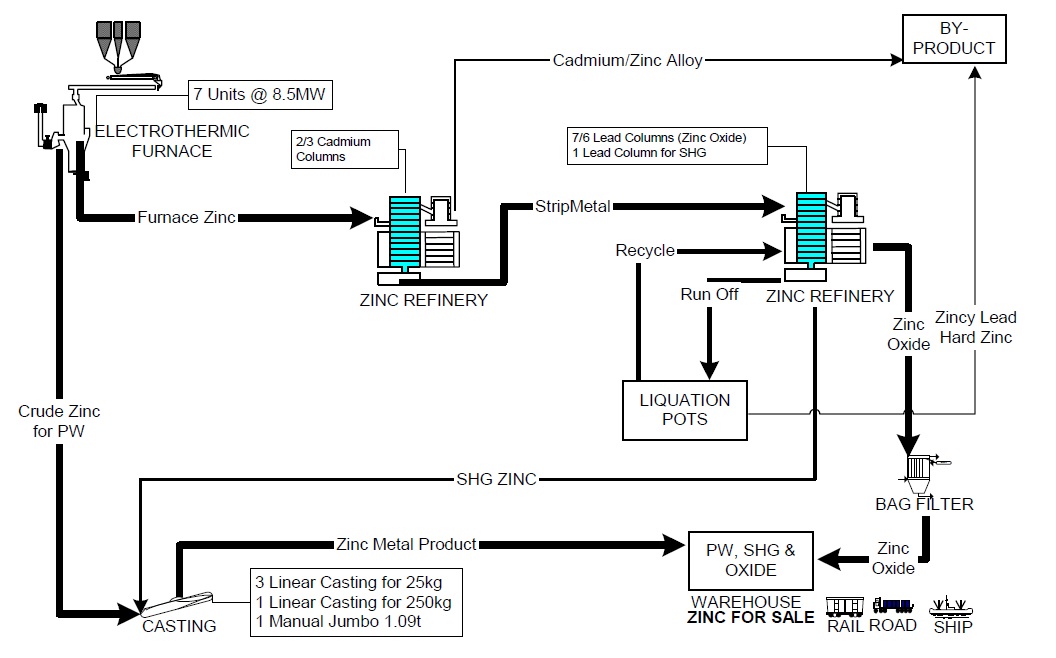| 1. |
The Horsehead Monaca smelter used the __________ Process, a pyro metallurgical process requiring a distillation plant for refining. |
|
|
Hydro metallurgical |
|
|
Electro thermic |
|
|
Endo thermic |
|
|
None of the above |
| 2. |
What does the following figure represents?
 |
|
|
Monaca zinc refinery schematic |
|
|
Monaca cadmium chamber |
|
|
Monaca recycling schema |
|
|
None of the above |
| 3. |
Leaks occur in a column as a result of unintended thermal stress. |
|
|
True |
|
|
False |
| 4. |
The rapid outflow of __________ vapor and droplets of superheated liquid immediately ignited causing a pressure surge that destroyed the combustion chamber wall and created a major conflagration in the workplace.
|
|
|
Zinc |
|
|
Cadmium |
|
|
Aluminum |
|
|
None of the above |
| 5. |
"Pressure Cooker Explosion" constitutes the major life-threatening hazard of the New Jersey process, Risk management has to be directed at preventing sump restrictions and identifying those that do occur early enough to take remedial action. The principal steps for achieving this are? |
|
|
Best practice standards of management |
|
|
Taking all possible steps to prevent the ingress of air to the column |
|
|
Best practice standards of training and awareness and good operator plant information systems |
|
|
All of the above |
| 6. |
At Monaca, sinter and pea coke were preheated to around ______ in drums fired with electro thermic furnace off gas, and charged to the electro thermic furnace by means of rotary distributors. |
|
|
50ºC |
|
|
100ºC |
|
|
250ºC |
|
|
500ºC |
| 7. |
In a zinc distillation column the upper half, the reflux section, is heated and is not insulated to varying degrees and works not to rectify and refine the rising vapor. |
|
|
True |
|
|
False |
| 8. |
Hard zinc is __________than zinc. |
|
|
Lighter |
|
|
Heavier |
|
|
Weighs the same |
|
|
None of the above |
| 9. |
The explosion and fire on column B at Horsehead Monaca in July 2010 was an example of a Pressure Cooker Explosion.
|
|
|
True |
|
|
False |
| 10. |
In the PAUSE FOR THOUGHT concept for the Pause – Sump Burner not heating column on start-up – Blockage and Thought – Sump not clear. Column MUST be commissioned properly. What is the appropriate remedial action? |
|
|
Check and if necessary rebuild sump before column rebuild |
|
|
Delay heat-up until issue rectified and danger removed |
|
|
General warning for EXTREME CAUTION |
|
|
Cut feed – Emergency plan – Prepare for shutdown if sump not cleared |
| 11. |
From the analysis of the data and causes of the explosion, column B partially blocked at the sump and backfilled with molten zinc and then exploded, this happening over the day to evening shift change period. |
|
|
True |
|
|
False |
| 12. |
Zinc is a highly reactive metal, particularly in vapor form. |
|
|
True |
|
|
False |
| 13. |
Which of the following alternative scenarios could have caused the explosion? |
|
|
Water leakage |
|
|
A gas explosion |
|
|
Broken trays |
|
|
None of the above |
| 14. |
Whilst the column that exploded at Monaca in 2010 was a cadmium column and hard zinc formation is more likely to occur on lead (zinc oxide) columns, is it appropriate to examine the formation of hard zinc in more detail? |
|
|
True |
|
|
False |
| 15. |
____________, particularly of feed rate and firing, not only provides steady conditions and a long column life with less leakage, but it also helps to avoid the fluctuating conditions that can allow air to enter the column and lead to further difficulties. |
|
|
Steady operation |
|
|
Unsteady operation |
|
|
Regular operation |
|
|
None of the above |
|